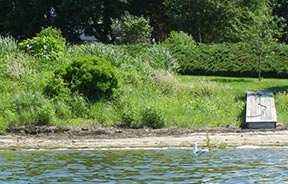Why Plant
Coastal riparian corridors between water and residential area. Top photo by Kara Bonsack, UConn CLEAR, bottom photo by Judy Rondeau.
Riparian plantings are vegetation corridors directly adjacent to the water’s edge separating the water from upland areas. The term “riparian” refers to the area by the banks of a river, stream, or other body of water, and “corridor” refers to a designated zone or strip of land of a specified width along the border of an area. So a “riparian corridor” is the natural vegetation and soil cover adjacent to a river, stream, or other body of water. This corridor is a critical area at the land/water interface and native plantings can play a significant role in protecting water quality and aquatic habitats. Coastal riparian corridors refer to those vegetated areas interfacing between the marine or brackish waters of Long Island Sound and upland areas.
There are more than 23 million people living within 50 miles of Long Island Sound. Population pressures have led to an increase in impervious surfaces such as roads, parking lots and roofs. These impervious surfaces cause greater storm runoff carrying pollutants, sediments and nutrients into our waterways. The Environmental Protection Agency’s (EPA) Long Island Sound Study, which funded the development of this tool, is dedicated to working with federal, state and local partners to restore and protect Long Island Sound waters and resources.
Map showing the Long Island Sound Study area (NEP refers to the EPA’s National Estuary Program which includes Long Island Sound)
Coastal riparian areas provide many useful functions for Long Island Sound and coastal properties including filtration of storm runoff. They slow water runoff (both surface flow and subsurface flow), minimize erosion, trap and filter pollutants and nutrients, and provide wildlife habitat. When done properly, they also provide privacy, increase property value and beautify the landscape.
Even though this website focuses on creating riparian corridors for the coastal areas of Long Island Sound, part of the north shore of Long Island and nearly the entire state of Connecticut are within the Long Island Sound watershed. It is critical to keep in mind that what happens in the upper reaches of the watershed impacts the waters of the Sound. Riparian corridors, whether inland or coastal, have significant functions and values.
Our climate is changing with both air and surface water temperatures increasing. By planting vegetation along waterways we can help shade the water and maintain cooler water temperatures for fish and other aquatic organisms, as well as have shade in our yards. We are also seeing changes in the magnitude and seasonality of precipitation and run-off. Again, riparian vegetation increases filtration of runoff into the soil and filters pollutants, so planting riparian corridors can only help with the changes we are starting to see in our climate.




